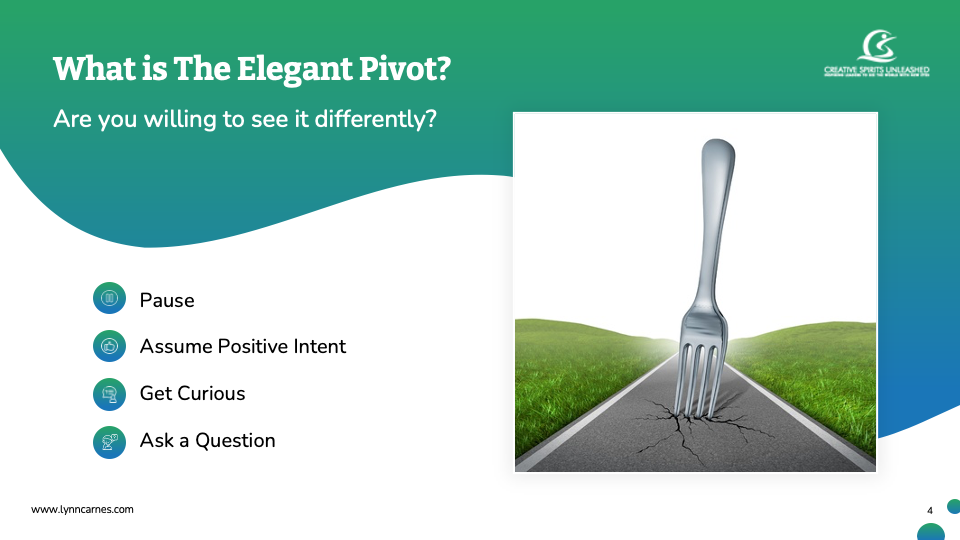One of the best inventions ever is the deadline. The Elegant Pivot workbook went out to those who asked to be on the “early tester” list because of two deadlines. The first was self-imposed. I promised it by November 4. If I had not given myself a deadline, I would have kept dragging it out. The second deadline came from of a client’s request.
She asked me to facilitate a session for a fast-growing new team on how to use The Elegant Pivot as part of their “forming/storming/norming” process. It makes sense, because new teams offer all kinds of opportunities for people to assume the worst. I know this one very well from past experience. If you read The Elegant Pivot, you know some of my worst moments. But, I also know this one from recent experience. In other words, I’m still working on this stuff. Getting ready for the session, I had a moment that went from bad to worse to hilarious to serendipitous.
It started with designing the PowerPoint. In the middle of doing the workbook, I realized we would need a simple set of slides for the Zoom session. The content was no problem; getting the slides to look good? Designing slides is not my thing. I would need help for that.
So, as I often do, I went off to Fiverr to pick a new, temporary team member to help me out. He quickly turned my amateur looking slides into a truly professional package. I was blown away by how GOOD the slides looked. There were just some small changes needed. On the slide describing “What is The Elegant Pivot?” he had a picture of a stack of messy books.

I assumed that picture was a placeholder, and sent back this message:
Slide 4: The picture should reflect a PIVOT - like a basketball players foot planted or something that shows a change in direction
The next version had a picture of a basketball player dunking.

Ok. He heard me. Sort of. The feet were in the picture – but it really wasn’t the look I was going for. So next round, I said this:
Slide 4 - This picture is definitely not the point. Let's do a picture of a fork in the road instead
In my mind, I was picturing the classic picture of a road with trees lining it, offering two paths, perhaps with fall colors.

Then I got what felt like a bucket of cold water thrown on me. As I scrolled through the latest version, here’s what he sent:

For a split second, I thought “What the H#$##? This is terrible! What a horrible designer!” And then I paused. I wondered: Why this picture? I went back to read my request and realized that he had given me EXACTLY what I had asked for. We clearly had a language and culture barrier. However, he was doing his best to give me what I wanted. Beautiful. I showed it to Russ and started laughing so hard I thought my sides would split.
My temporary teammate had given me a better illustration of The Elegant Pivot than all the pictures of beautiful fall-colored roads could ever do. All I had to do was be willing to see it differently.
It’s one of the lessons I’ve been discovering as I’ve been riding so many different horses. When they do something different than what I asked for, I’ve learned to stop and think about what my mind or my hand or my legs were doing. Almost every single time, the horse was giving me EXACTLY what I had asked for. If I will just pause and ask myself “What assumptions am I making? Where am I expecting the horse to read my intention?”, I will almost always discover that I was expecting the horse to fill in gaps in my ability to speak his language.
It makes me wonder where else I’m getting exactly what I’m putting out there. This lesson gives new meaning to one of The Four Agreements. “Be impeccable with your word.” So often, we assume that others have the same assumptions we do. Then we draw conclusions based on the unseen or expect them to read our mind or share all of our backstory so they can do things our way.
In the moment right after I thought What the heck? I was able to see it differently. What looked like a mistake was actually a gift.
The core question behind The Elegant Pivot is simple and yet profound: “Are you willing to see it differently?” Until you can answer that question in the affirmative, there’s no reason to pause and assume positive intent.
The two paths in the road are not always equally tempting. The “what the heck” path is more like a well-greased, slippery slide that gains momentum with every thought. The “assume positive intent” path - after the pause- requires me to pivot before I fall into the easy road.
After my hilarity waned, I was left with the question of what to do about the slide. A part of me just wanted the designer to drop my “forest path” picture into the deck and be done with it. However, the story is too good at illustrating the point. So, the fork in the road and the story stays.
Where are you getting exactly what you asked for? Where are your assumptions still invisible? What are some ways you could be even more impeccable with your word? The next time something doesn’t go as planned, are you willing to see it differently?

